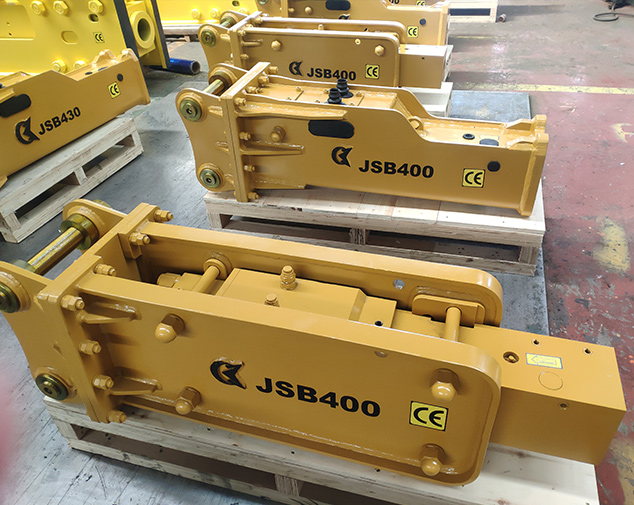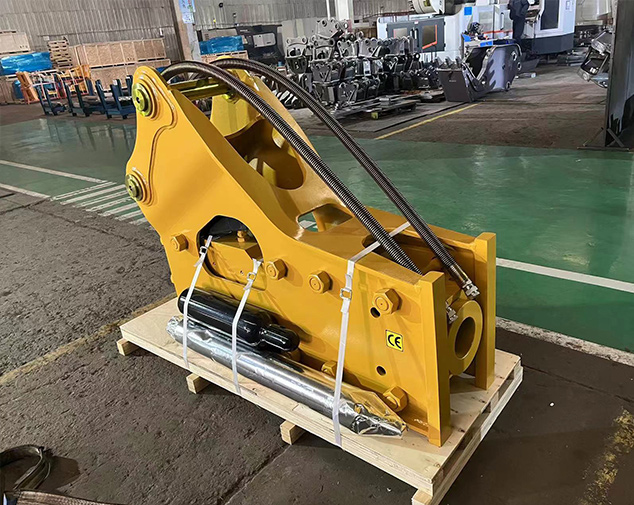Detailed Examination of Hydraulic Hammer Parts and Their Roles
A detailed examination of hydraulic hammer parts and their roles is crucial to understanding their operation and efficiency. A comprehensive understanding of the parts of a hydraulic hammer and their roles can significantly improve the operation and maintenance of this machinery.
Core Components of Hydraulic Hammers
Cylinder Assembly and Its Importance
The cylinder assembly is the backbone of any hydraulic hammer. Here resides the piston, which is important for making hydraulic into mechanical power. So this particular component will need to be designed to operate under high-pressure conditions while also being very durable.
It is commonly restrained with high-strength steel that is tempered to provide a hard, wear-resistant exterior for an extended service life and stable tracking.
Piston Mechanism in Hydraulic Hammers
The piston is really an essential part of a hydraulic hammer, which works to drive the impact energy. Powered by hydraulic pressure, it travels up and down inside the cylinder to hit the chisel or tool at great speed.
Its construction is typical of high-grade alloy steel, providing that the piston can withstand repeated stress without deforming. Its accurate displacement inside the cylinder is essential to ensuring consistent impact energy and general performance.
The Functionality of the Accumulator
Within a hydraulic hammer, the accumulator acts as a hydraulic energy storage, storing high-pressure hydraulic fluid and releasing it when needed. Such a mechanism balances pressure variations which offer smoother corrective actions while taking a load off other vehicle parts. It also boosts performance and longevity, by maintaining the energy output stable.
Impact Force: The Role of the Chisel
The chisel is the part that interacts with the workpiece at the end of the hydraulic hammer. It transfers the energy of impact generated by the piston to break or shape materials like concrete or rock.
Chisels have a wear-resistant alloy steel base with extremely sharp tips that can withstand substantial forces over long treatment times. Using the best kind of chisel type for particular jobs for that job done can reduce breaking and preserve the edge types.
Supporting Components in Hydraulic Hammers
Valve Systems and Their Contribution to Performance
Valve systems control the flow of hydraulic fluid within a hydraulic hammer and are responsible both for the speed of activation, as well as the impact force. High-pressure valve design and precision engineering allow effortless transitions between high-pressure states, enabling greater operational control and efficiency. These machines have more sophisticated designs and the devices minimize fluid leakage and cut back the time and effort for maintenance.
Seals and Bushings: Ensuring Durability
Seals keep hydraulic fluid from escaping vital elements such as cylinders and pistons, while bushings serve to both give structural support and reduce friction between moving elements.
High-quality, well-fitted rubber and synthetic polymer seals guarantee that nothing ever leaks under even the most extreme conditions. Bushings are also made of hardened steel or composite materials to reduce wear and consequently prolong the life of components.
Hydraulic Hoses and Connections
Hydraulic hammers use hydraulic hoses that connect to the various components of the hydraulic hammer and hydraulic energy, to move fluid under high pressure. These hoses need to be strong enough to withstand severe operations without bursting or going off over time. The connection is crucial for guaranteeing leak-free joints; hence, modern designs include quick-connect fittings for ease of maintenance.
Maintenance-Related Parts in Hydraulic Hammers
Wear Plates and Their Replacement Cycle
Wear plates protect the hydraulic hammer’s critical surfaces from abrasion during operation. Constructed from extremely tough materials such as hardened steel or composite alloys, these protectors absorb impact forces that cause injury to critical components. Be sure to check them and replace them as needed.
Lubrication Systems for Optimal Performance
Proper lubrication reduces friction in the hydraulic hammer, which helps eliminate heat that can cause premature wear. Automated lubrication systems dispense exact quantities of grease or oil to main areas which maintains consistency and reliability with a minimum of manual intervention.
Kingho: A Leader in Hydraulic Hammer Technology
Key Features of Kingho Hydraulic Hammer Products
Companies that work in construction, demolition, mining or any heavy industry often use hydraulic hammers, one of the most efficient of all the tools they have at disposal. Kingho‘s products are recognizable by their high sturdiness, efficiency, and versatility for multiple applications.
These hammers are designed for high performance and durability, utilizing specialized metal-cutting manufacturing processes and high-strength materials. Key components such as chisels and pistons utilize wear-resistant alloy steel to ensure long service life and consistent impact force per operation.
Additionally, the use of precision-engineered valve systems promotes smooth hydraulic fluid transfer, further enhancing the overall efficiency of these machines. Such features are what make hydraulic hammers extremely reliable even in the face of harsh working conditions.
Recommended Kingho Models for Various Applications
Models play a major role in getting your maximum productivity. The side-type hydraulic breaker has unrivaled power and efficiency in heavy-duty operations, such as breaking hard rock or reinforced concrete.
Contrarily, the box-type model is suitable for minimizing noise emissions, which is preferable in urban construction sites. Top-type hydraulic hammers provide an even mix of power and precision and as a result, are a good choice for projects that require a versatile solution.
Each model can be tailored to specific operational needs, which assures you of having the right tool for the project. Kingho offers technical support.
Customization Options for Specific Project Needs
The customization potential of these hydraulic hammers is truly commendable. It provides custom specifications for specific project requirements, including structural changes and adjustments to the operational range.
Its versatility affords a perfect complement between equipment and project requirements while remaining static, stable and reliable.
Enhancing Efficiency Through Quality Hydraulic Hammer Parts
The Role of High-Quality Materials in Component Longevity
The service life of hydraulic hammer spare parts is determined by the quality of the materials used. In order to withstand the extreme forces that are generated during operation, high-strength steels and wear-resistant alloys are frequently utilized.
These significantly impactful materials found in components such as pistons, chisels, and seals, help them last longer with lower wear rates. For example, the high-grade alloy steel pistons withstand repeated impacts without deformation, ensuring consistent performance.
FAQs
Q1. What should you consider when choosing a hydraulic hammer?
A: Take into account the material you will be processing, the pressure force to cut it, and the environmental constraints including noise level and space.
Q2: How frequently should we check hydraulic hammer components?
A: Depending on how often a vessel is used, maintenance should be performed after approximately 200-300 hours of operation, or as directed by the manufacturer.
Q3: Is it possible to have a specialized hydraulic hammer?
A: Yes, a lot of manufacturers can tailor adjustable specifications, such as structural form and operational range, for unique project requirements



